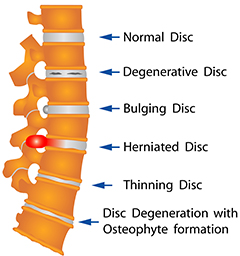Herniated Disc
Description:

Within the spinal column there are discs between each vertebrae. These discs are the spine’s shock absorbers, and have two layers. The outer layer is a thick tissue called the annulus, and the middle layer is a jelly-like substance called the nucleus pulposus. The discs are in front of the spinal cord and exiting nerves. When a disc is herniated the middle layer breaks through the outer tissue, and this condition can result in compression of the nerves surrounding the disc.
Symptoms:
- Back or neck pain
- Shooting Pain radiating into legs or arms on one or both sides
- Numbness and/or tingling in arms and legs
- Muscle weakness and/or spasms in arms and legs
In some severe cases, changes in bladder or bowel function, progressive weakness or paralysis may occur. Consult your doctor immediately if this is ever experienced
Causes:
- Genetics
- Normal aging
- Trauma
- Obesity/unhealthy life styles
Screening and Diagnosis:
As always, complete medical history and physical examination is key in the diagnosis of a herniated disc. Also, CT or MRI may be ordered for further evaluation. X-ray is not always recommended in this case, as they can’t show a bulging disc, but they can show a general idea of how much spine degeneration is present.
Treatment:
Non-surgical options for a herniated disc include:
- physical therapy
- non-steroidal anti-inflammatory medications, muscle relaxants, and in some cases pain medicine
Injection therapy:
- Intralaminar epidural injection
- Transforaminal epidural injection
- Caudal epidural injection
Surgical intervention:
For patients with herniated disc pain who fail to improve with usual care, surgical intervention can be considered to relief the pressure off of the spinal nerves.
Related Research Articles
Title: Medical Ozone in Herniated Disc: A Classical Review
Authors: Sardar K, Das G, Mahta P, Mallick S and Hubbard R
Journal: Pain & Relief

